Tom Clinton
 Tom Clinton
Tom Clinton
Research Staff Member
HGST, a Western Digital company San Jose Research Center
Website: http://www.HGST.com/
 Tom Clinton is a research staff member (RSM) at HGST’s San Jose Research Center, in the heart of Silicon Valley. HGST is a leader in magnetic recording technology and a division of Western Digital company, the world’s largest manufacturer of hard disc drives. The majority of scientists employed at HGST work on applied research to advance data storage technology.
Tom Clinton is a research staff member (RSM) at HGST’s San Jose Research Center, in the heart of Silicon Valley. HGST is a leader in magnetic recording technology and a division of Western Digital company, the world’s largest manufacturer of hard disc drives. The majority of scientists employed at HGST work on applied research to advance data storage technology.
“I received my BS in Math and Physics from Georgetown in 1986, and my Bachelor of Electrical Engineering (BEE) from the Catholic University of America in 1987. Following the completion of my BEE, I began graduate school at the University of Maryland where my doctoral thesis was on magnetic properties of superconductors. After receiving my PhD in Physics in 1992, I held postdoc positions both at Maryland and the Naval Research Laboratory (NRL). My experience in magnetic storage began with my position at NRL where my work was on hybrid ferromagnetic-superconductor thin film devices for use as nonvolatile memory. In 1999, I began my career in the hard disk drive (HDD) industry at Seagate Technology’s Pittsburgh Research center, where I spent a decade working on advanced storage technologies. I then headed West, ultimately to Silicon Valley and HGST.
At HGST, our research is focused on developing new technology for writing and reading bits (magnetic transitions) on a disc. In recent years, bit areal densities have increased rapidly in an unprecedented effort to increase the storage capacity of drives. The corresponding technology is increasingly sophisticated, and further advancing it presents scientists and engineers with numerous challenges and unlimited opportunity for discovery. For example, to read a single bit, a head detects a fraction of a flux quantum, with spatial resolution on the order of 10 nm (the size and spacing of bits), and at data rates of several GHz i.e. the bit passes under the reader for roughly a nanosecond. Current readers are thin-film tunneling magneto-resistance (TMR) field sensors. A write head is equally challenging to advance, as a thin film inductive writer must locally generate fields on the order of a Tesla, modulate this field at frequencies of more than a GHz, and focus it with spatial resolution better than 50 nm. We have advanced technologies that integrate optical elements and plasmonic devices to meet the requirements of future products, where storage capacities will push bit densities in excess of a trillion bits per square inch (Terabit per inch squared).
While there are similarities between university, national and industrial labs, industrial research is faster-paced because of market competition necessitating the timely transfer of research to technology development. Industry is inherently multidisciplined, as is the case at HGST. Our lab, for example, engages researchers with backgrounds in physics, chemistry, materials science, and electrical, chemical and mechanical engineering, who routinely interact with each other. My background in physics has proven to be fundamental to my research where E&M, quantum mechanics and solid state physics are a second language. More over, since physics provides the foundation for all science and engineering, I am able to interact and collaborate effectively in this interdisciplinary environment. To be exposed to business and industry through a program, such as at Georgetown, should significantly expand a physicist’s options upon entering the job market. There are more jobs in industry than at universities and national labs, but physics programs do not seem to readily direct students to industry. As a result, other disciplines are filling the void. For example, in industry you will likely find more PhD electrical engineers doing solid state physics than PhD physicists. I think Georgetown’s program is progressive and welcome.”
